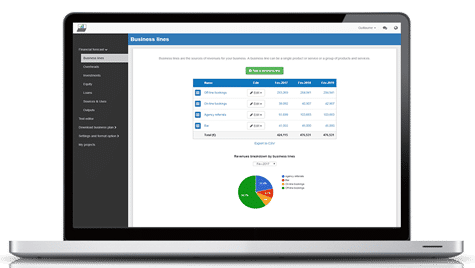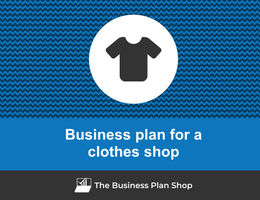How to create a financial forecast for a clothes shop?

If you are serious about keeping visibility on your future cash flows, then you need to build and maintain a financial forecast for your clothes shop.
Putting together a clothes shop financial forecast may sound complex, but don’t worry, with the right tool, it’s easier than it looks, and The Business Plan Shop is here to guide you.
In this practical guide, we'll cover everything you need to know about building financial projections for your clothes shop.
We will start by looking at why they are key, what information is needed, what a forecast looks like once completed, and what solutions you can use to create yours.
Let's dive in!
Why create and maintain a financial forecast for a clothes shop?
The financial projections for your clothes shop act as a financial blueprint to guide its growth with confidence and ensure its long-term financial viability.
To create them, you will need to look at your business in detail - from sales to operating costs and investments - to assess how much profit it can generate in the years to come and what will be the associated cash flows.
During challenging market conditions, maintaining an up-to-date financial forecast enables early detection of potential financial shortfalls, allowing for timely adjustments or securing financing before facing a cash crisis.
Your clothes shop's financial forecast will also prove invaluable when seeking financing. Banks and investors will undoubtedly request a thorough examination of your financial figures, making precision and presentation essential.
Need a solid financial forecast?
The Business Plan Shop does the maths for you. Simply enter your revenues, costs and investments. Click save and our online tool builds a three-way forecast for you instantly.
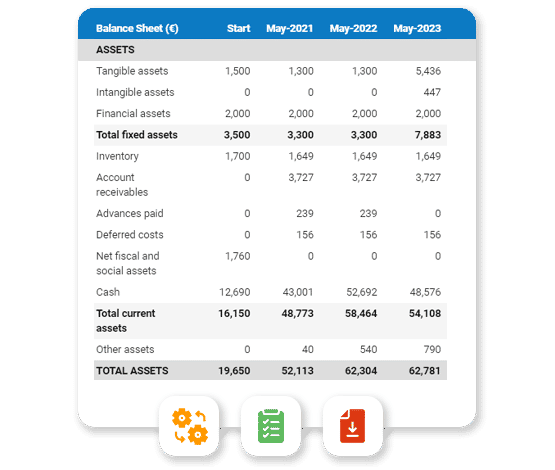
What information is used as input to build a clothes shop financial forecast?
A clothes shop's financial forecast needs to be built on the right foundation: your assumptions.
The data required to create your assumptions will depend on whether you are a new or existing clothes shop.
If you are creating (or updating) the forecast of an existing clothes shop, then your main inputs will be historical accounting data and operating metrics, and your team’s view on what to expect for the next three to five years.
If you are building financial projections for a new clothes shop startup, you will need to rely on market research to form your go-to-market strategy and derive your sales forecast.
For a new venture, you will also need an itemised list of resources needed for the clothes shop to operate, along with a list of equipment required to launch the venture (more on that below).
Now that you understand what is needed, let’s have a look at what elements will make up your clothes shop's financial forecast.
The sales forecast for a clothes shop
The sales forecast, also called topline projection, is normally where you will start when building your clothes shop financial forecast.
Creating a coherent sales projection boils down to estimating two key drivers:
- The average price
- The number of monthly transactions
To do this, you will need to rely on historical data (for an existing business), market research data (for both new and existing clothes shops), and consider the elements below:
- Seasonal trends: The changing seasons can greatly impact the average price and number of monthly transactions in a clothes shop. For example, during summer months, customers may be more likely to purchase lighter and more casual clothing, resulting in a decrease in the average price but an increase in the number of transactions.
- Fashion trends: The ever-changing fashion industry can also have a significant impact on a clothes shop's sales forecast. If a particular trend becomes popular, such as a certain color or style, customers may be more likely to purchase items that fit that trend, resulting in a potential increase in the average price and number of transactions.
- Economic conditions: Economic factors such as inflation, unemployment rates, and consumer confidence can greatly influence a clothes shop's sales forecast. For example, during times of economic downturn, consumers may have less disposable income, leading to a decrease in the average price and number of transactions in the store.
- Competition: The presence of other clothing stores in the same area can also affect a clothes shop's sales forecast. If there are many competitors selling similar products at lower prices, the shop may need to adjust their average price to remain competitive, potentially resulting in a decrease in the average price and number of transactions.
- Product quality: The quality of the clothing sold in the shop can also impact the sales forecast. If the shop is known for selling high-quality and durable clothing, customers may be willing to pay a higher average price, resulting in an increase in the average price and potentially the number of transactions.
After the sales forecast comes the operating expenses budget, which we will now look into in more detail.
Need inspiration for your business plan?
The Business Plan Shop has dozens of business plan templates that you can use to get a clear idea of what a complete business plan looks like.

The operating expenses for a clothes shop
Once you know what level of sales you can expect, you can start budgeting the expenses required to operate your clothes shop on a daily basis.
Expenses normally vary based on how much revenue you anticipate (which is why, from experience, it is always better to start your forecast with the topline projection), and where your business is based.
Operating expenses for a clothes shop will include some of the following items:
- Rent: The cost of leasing a physical retail space for your clothes shop.
- Utilities: Expenses related to electricity, water, and other utilities needed to run your shop.
- Inventory: The cost of purchasing and replenishing your stock of clothing items.
- Staff Costs: Salaries, wages, benefits, and training for your employees.
- Accountancy Fees: Fees paid to a professional accountant for financial and tax-related services.
- Insurance Costs: Insurance premiums to protect your shop, inventory, and employees.
- Marketing and Advertising: Expenses for promoting your clothes shop, including advertising, social media, and influencer collaborations.
- Software Licences: Fees for software used to manage your shop, such as point-of-sale systems and inventory management software.
- Banking Fees: Charges for using banking services, such as credit card processing fees and bank account maintenance fees.
- Maintenance and Repairs: Costs for repairing and maintaining your shop, including fixtures, equipment, and displays.
- Professional Services: Fees paid to lawyers, consultants, or other professionals for specific services related to your clothes shop.
- Supplies: Expenses for office supplies, packaging materials, and other supplies needed to run your shop.
- Licenses and Permits: Fees for obtaining necessary licenses and permits to operate your clothes shop.
- Rent and Property Taxes: Additional costs associated with leasing a physical retail space, such as property taxes and common area maintenance fees.
- Credit Card Fees: Charges for accepting credit card payments from customers.
This list will need to be tailored to the specificities of your clothes shop, but should offer a good starting point for your budget.
What investments are needed to start or grow a clothes shop?
Creating and expanding a clothes shop also requires investments which you need to factor into your financial forecast.
Capital expenditures and initial working capital items for a clothes shop could include elements such as:
- Store fixtures and equipment: This includes items such as display racks, shelving, cash registers, and signage. These are essential for creating an attractive and functional shopping environment for your customers.
- Point of sale (POS) system: A POS system is a computerized system used for sales transactions. It includes hardware, software, and peripherals such as barcode scanners and receipt printers. This is a crucial investment for managing sales, inventory, and customer data efficiently.
- Inventory: As a clothes shop, your primary source of revenue is selling clothing items. Therefore, it is essential to invest in a sufficient inventory to meet the demands of your customers. This includes purchasing a variety of sizes, styles, and quantities of clothing items.
- Renovation or remodeling: If you are starting a new clothes shop or moving to a new location, you may need to invest in renovation or remodeling costs. This can include painting, flooring, lighting, and other improvements to create an attractive and functional space for your business.
- Furniture and décor: In addition to store fixtures, you may also want to invest in furniture and décor items to enhance the aesthetic appeal of your shop. This can include items such as chairs, couches, mirrors, and artwork.
Again, this list is not exhaustive and will need to be adjusted according to the circumstances of your clothes shop.
Need a convincing business plan?
The Business Plan Shop makes it easy to create a financial forecast to assess the potential profitability of your projects, and write a business plan that’ll wow investors.
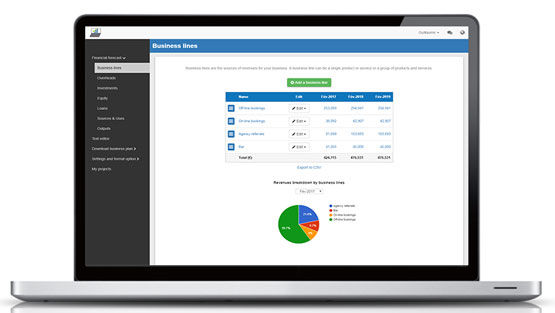
The financing plan of your clothes shop
The next step in the creation of your financial forecast for your clothes shop is to think about how you might finance your business.
You will have to assess how much capital will come from shareholders (equity) and how much can be secured through banks.
Bank loans will have to be modelled so that you can separate the interest expenses from the repayments of principal, and include all this data in your forecast.
Issuing share capital and obtaining a bank loan are two of the most common ways that entrepreneurs finance their businesses.
What tables compose the financial plan for a clothes shop?
Now let's have a look at the main output tables of your clothes shop's financial forecast.
The forecasted profit & loss statement
The profit & loss forecast gives you a clear picture of your business’ expected growth over the first three to five years, and whether it’s likely to be profitable or not.
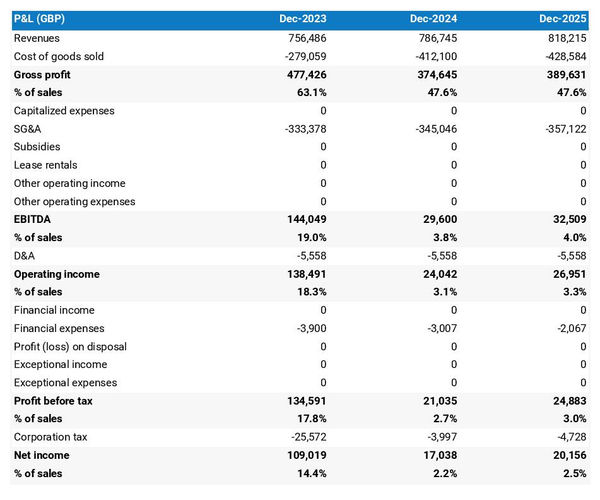
A healthy clothes shop's P&L statement should show:
- Sales growing at (minimum) or above (better) inflation
- Stable (minimum) or expanding (better) profit margins
- A healthy level of net profitability
This will of course depend on the stage of your business: numbers for an established clothes shop will look different than for a startup.
The projected balance sheet
The projected balance sheet gives an overview of your clothes shop's financial structure at the end of the financial year.
It is composed of three categories of items: assets, liabilities and equity:
- Assets: are what the business possesses and uses to produce cash flows. It includes resources such as cash, buildings, equipment, and accounts receivable (money owed by clients).
- Liabilities: are the debts of your clothes shop. They include accounts payable (money owed to suppliers), taxes due and bank loans.
- Equity: is the combination of what has been invested by the business owners and the cumulative profits to date (which are called retained earnings). Equity is a proxy for the value of the owner's stake in the business.

The cash flow projection
The cash flow forecast of your clothes shop will show how much cash the business is expected to generate or consume over the next three to five years.
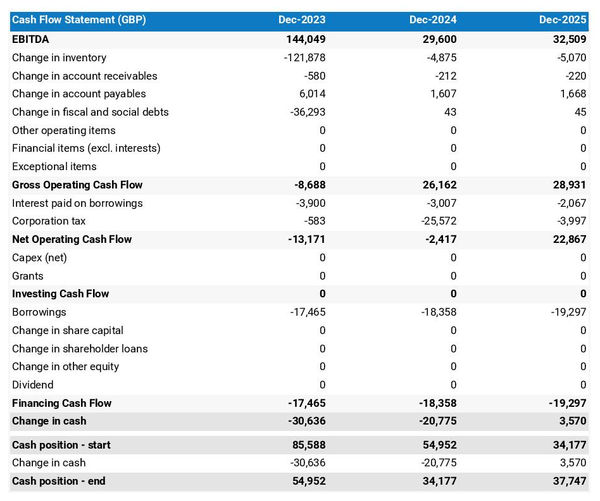
There are multiple ways of presenting a cash flow forecast but from experience, it is better to organise it by nature in order to clearly show these elements:
- Operating cash flow: how much cash is generated by the clothes shop's operations
- Investing cash flow: what is the business investing to expand or maintain its equipment
- Financing cash flow: is the business raising additional funds or repaying financiers (debt repayment, dividends)
Your cash flow forecast is the most important element of your overall financial projection and that’s where you should focus your attention to ensure that your clothes shop is adequately funded.
Note: if you are preparing a financial forecast in order to try to secure funding, you will need to include both a yearly and monthly cash flow forecast in your clothes shop's financial plan.
Need a solid financial forecast?
The Business Plan Shop does the maths for you. Simply enter your revenues, costs and investments. Click save and our online tool builds a three-way forecast for you instantly.

Which tool should you use to create your clothes shop's financial forecast?
Using the right tool or solution will make the creation of your clothes shop's financial forecast much easier than it sounds. Let’s explore the main options.
Using online financial forecasting software to build your clothes shop's projections
The modern and easiest way is to use an online financial forecasting tool such as the one we offer at The Business Plan Shop.
There are several advantages to using specialised software:
- You can easily create your financial forecast by letting the software take care of the financial calculations for you without errors
- You have access to complete financial forecast templates
- You get a complete financial forecast ready to be sent to your bank or investors
- You can easily track your actual financial performance against your financial forecast, and recalibrate your forecast as the year goes by
- You can create scenarios to stress test your forecast's main assumptions
- You can easily update your forecast as time goes by to maintain visibility on future cash flows
- You have a friendly support team on standby to assist you when you are stuck
- It’s cost-efficient and much cheaper than using an accountant or consultant (see below)
If you are interested in this type of solution, you can try our projection software for free by signing up here.
Calling in a financial consultant or chartered accountant
Outsourcing the creation of your clothes shop financial forecast is another possible solution.
This will cost more than using software as you can expect as your price will have to cover the accountant’s time, software cost, and profit margin.
Price can vary greatly based on the complexity of your business. For a small business, from experience, a simple three-year financial forecast (including a balance sheet, income statement, and cash flow statement) will start at around £700 or $1,000.
Bear in mind that this is for forecasts produced at a single point in time, updating or tracking your forecast against actuals will cost extra.
If you decide to outsource your forecasting:
- Make sure the professional has direct experience in your industry and is able to challenge your assumptions constructively.
- Steer away from consultants using sectorial ratios to build their client’s financial forecasts (these projections are worthless for a small business).
Why not use a spreadsheet such as Excel or Google Sheets to build your clothes shop's financial forecast?
You and your financial partners need numbers you can trust. Unless you have studied finance or accounting, creating a trustworthy and error-free clothes shop financial forecast on a spreadsheet is likely to prove challenging.
Financial modelling is very technical by nature and requires a solid grasp of accounting principles to be done without errors. This means that using spreadsheet software like Excel or Google Sheets to create accurate financial forecasts is out of reach for most business owners.
Creating forecasts in Excel is also inefficient nowadays:
- Software has advanced to the point where forecasting can be done much faster and more accurately than manually on a spreadsheet.
- With artificial intelligence, the software is capable of detecting mistakes and helping decision-making.
Spreadsheets are versatile tools but they are not tailor-made for reporting. Importing your clothes shop's accounting data in Excel to track actual vs. forecast is incredibly manual and tedious (and so is keeping forecasts up to date). It is much faster to use dedicated financial planning tools like The Business Plan Shop which are built specially for this.
Need a convincing business plan?
The Business Plan Shop makes it easy to create a financial forecast to assess the potential profitability of your projects, and write a business plan that’ll wow investors.

Use our financial projection templates for inspiration
The Business Plan Shop has dozens of financial forecasting templates available.
Our examples contain both the financial forecast, and a written business plan which presents, in detail, the company, the team, the strategy, and the medium-term objectives.
Whether you are just starting out or already have your own clothes shop, looking at our template is always a good way to get ideas on how to model financial items and what to write when creating a business plan to secure funding.

Takeaways
- A financial forecast shows expected growth, profitability, and cash generation metrics for your clothes shop.
- Tracking actuals vs. forecast and having an up-to-date financial forecast is key to maintaining visibility on your future cash flows.
- Using financial forecasting software is the modern way of creating and maintaining financial projections.
We hope that this guide helped you gain a clearer perspective on the steps needed to create the financial forecast for a clothes shop. Don't hesitate to contact us if you have any questions!
Need inspiration for your business plan?
The Business Plan Shop has dozens of business plan templates that you can use to get a clear idea of what a complete business plan looks like.

Also on The Business Plan Shop
Know someone who runs a clothes shop? Share our business guide with them!

